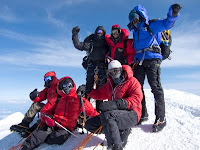Most activities have their own requirements for gloves, which will be influenced by weather, activity, terrain and temperature; even on a short trip you'll probably take more then one pair.
I'm always looking for the perfect 'light' glove, for when it's not too cold. One that fights off that first chill. One to fend off the wind. One to wear hiking, scrambling and crossing a glacier. It would be nice if they're lightweight too, and don't break the bank.
I had high hopes I had found that perfect glove when I came across the Extremities Lightweight Guide Glove.
They're light: my size XL's weigh only 58 grams.







































